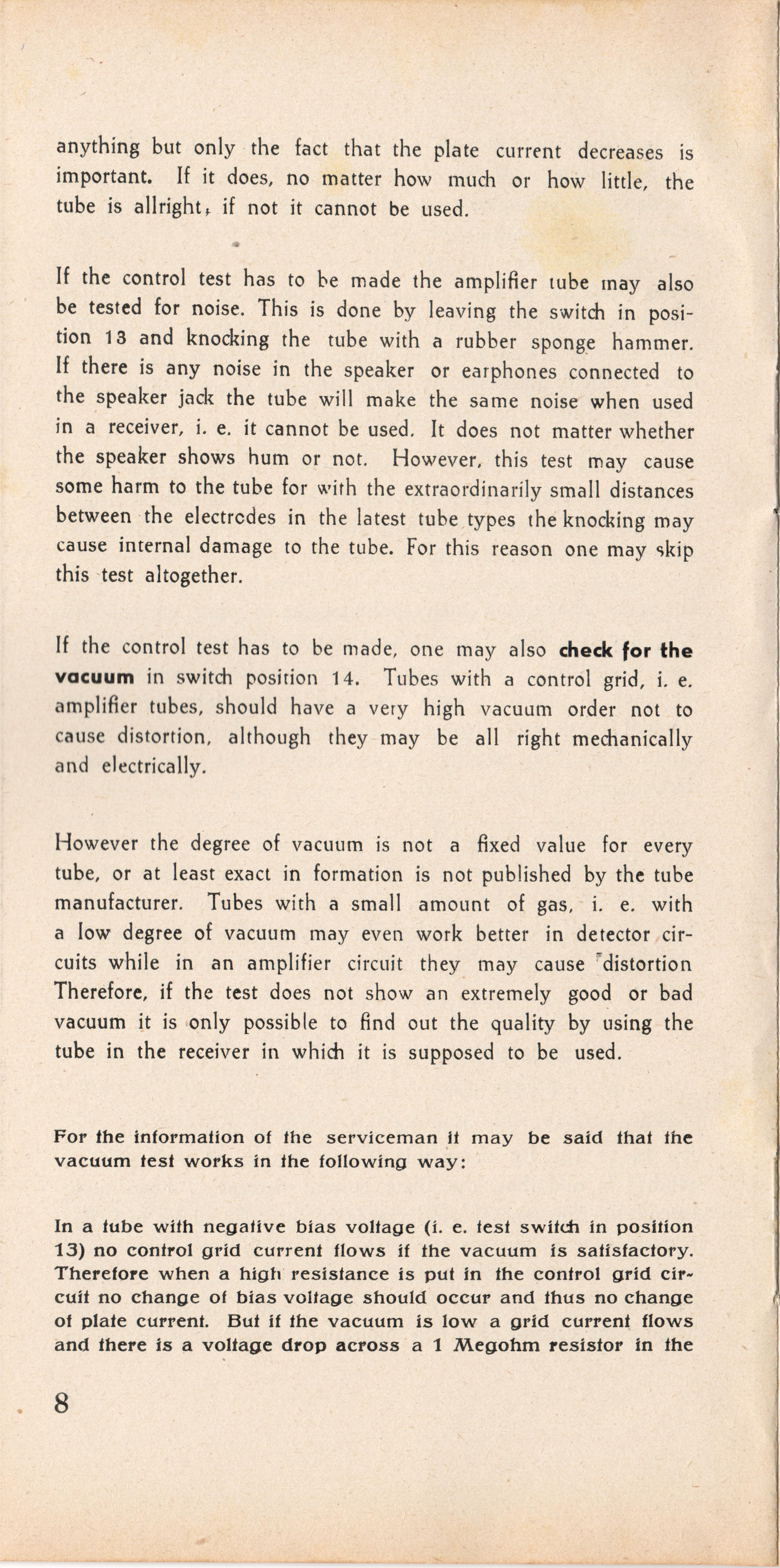Instruction for the Tube Tester Type W 19
| Titel | Instruction for the Tube Tester Type W 19 |
|---|---|
| Tags | |
| Hersteller | Funke (Adenau) |
| Breite × Höhe | 104 mm × 199 mm |
| Seitenanzahl | 16 |

Versionen der Bilder dieser Seite:
- Bearbeitet (169,4 kB)
- Unbearbeiteter Scan (13,2 MB) – Angezeigte Version
Text auf dieser Seite
anything but only the fact that the plate current decreases is important. If it does, no matter how much or how little, the tube is allright, if not it cannot be used.
If the control test has to be made the amplifier tube may also be tested for noise. This is done by leaving the switch in position 18 and knocking the tube with a rubber sponge hammer. If there is any noise in the speaker or earphones connected to the speaker jack the tube will make the same noise when used in a receiver, i. e. it cannot be used. It does not matter whether the speaker shows hum or not. However, this test may cause some harm to the tube for with the extraordinarily small distances between the electrodes in the latest tube types the knocking may cause internal damage to the tube. For this reason one may skip this test altogether.
If the control test has to be made, one may also check for the vacuum in switch position 14. Tubes with a control grid, i. e. amplifier tubes, should have a very high vacuum order not to cause distortion, although they may be all right mechanically and electrically.
However the degree of vacuum is not a fixed value for every tube, or at least exact in formation is not published by the tube manufacturer. Tubes with a small amount of gas, i. e. with a low degree of vacuum may even work better in detector circuits while in an amplifier circuit they may cause distortion Therefore, if the test does not show an extremely good or bad vacuum it is only possible to find out the quality by using the tube in the receiver in which it is supposed to be used.
For the information of the serviceman it may be said that the vacuum test works in the following way:
In a tube with negative bias voltage (i. e. test switch in position 13) no control grid current flows if the vacuum is satisfactory. Therefore when a high resistance is put in the control grid circuit no change of bias voitage should occur and thus no change of plate current. But if the vacuum is low a grid current flows and there is a voltage drop across a 1 Megohm resistor in the
Weitere Dokumente in diesem Satz „Konvolut Dokumente Funke Adenau“:
- Schaltplan W20
- Prüfkartenindex im Kartenformat
- Hinweiszettel: „Vorsicht! Empfindliche Elektrische Meßgeräte“
- Transistor-Adapter für die Röhrenmeßgeräte W19 + W20
- FUNKE – Personenruf-Funkanlage in freier Strahlung
- FARBFERNSEHBILDRÖHREN-MESSGERÄT für den Kundendienst
- FUNKE-Oszillograf
- Briefumschlag groß
- Bedienungsanweisung zum FUNKE-Röhrenvoltmeter Type: W22
- Standard-Röhrenvoltmeter
- FUNKE TUBE TESTER MODEL W 19
- FUNKE TUBE TESTER Model W 20
- Bildröhrenmeßgerät für den Kundendienst Modell W 21
- Preisliste – Meßgeräte der Firma Max FUNKE KG. – Gültig ab Juli 1968
- Datenblatt EL509
- Datenblatt PCL200
- Datenblatt PL509
- Briefumschlag klein
- Briefumschlag Luftpost
- Versandtasche metrofunk
- Unbekannte Skizze
- Prospekt W21/II mit „NEU“-Stempel